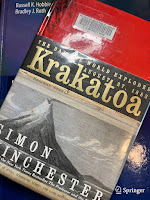If you shine x-rays through a material and measure the number absorbed by it, you create an x-ray absorption spectrum. The absorption is related to the cross section; the bigger the cross section, the more the x-rays are absorbed. Figure 15.2 from Intermediate Physics for Medicine and Biology is shown below, where the cross section for carbon is plotted as a function of the x-ray energy. I’ve drawn an oval around what’s the most interesting feature of the plot, the jump in the cross section at an energy of about 0.28 keV. This abrupt rise is known as the K edge, and is an example of an absorption edge.
 |
| A slightly modified version of Figure 15.2 from Intermediate Physics for Medicine and Biology. |
The cross section jumps up when the photon’s energy rises above the binding energy of a K-shell electron [an electron in the innermost energy level]. It’s not a small effect; the cross section increases by more than a factor of ten at the K edge (note that this is a log-log plot).
When I see such a dramatic effect, I imagine how surprising it must have been for the person who observed it first. Who was the person who discovered the K edge? Maurice de Broglie.
 |
| Maurice de Broglie in 1932. |
Farrel Lytle, an x-ray spectroscopy pioneer, tells Maurice’s story in his review article (Journal of Synchrotron Radiation, Volume 6, Pages 123–134, 1999).
Although Röntgen represents the beginning of X-ray science, the remarkable de Broglie royal family has been significant in both the world of science and the history of France. It has been said that if Maurice did nothing more than convince his younger brother, Louis, to drop his study of history and begin a career in science, he should be memorialized for that alone. But he did considerably more than that. His work in X-ray and atomic physics was innovative and important. Maurice had begun a career as a naval officer, but became interested in the exciting new world of X-rays and physics and resigned his commission. Beginning in the laboratory of Paul Langevin working on the ionization of gases by X-rays, he later built his own laboratory in his personal mansion on rue Châteaubriand. There he became the first in France to work with X-ray diffraction. During these experiments he invented X-ray spectroscopy. The experimental innovation came about when he mounted a single crystal on the cylinder of a recording barometer where the clockwork mechanism rotated it around its vertical axis at 2° h−1. As the crystal rotated, all angles between the incident beam and the diffraction planes (hence, all X-ray energies) were recorded on a photographic plate. In this way he obtained an X-ray line spectrum from the tube with sharp and diffuse lines, bands etc. Two of the absorption bands proved to be the K edges of Ag and Br in the photographic emulsion. This was the first observation of an absorption edge (de Broglie, 1913). It took a few more experiments to reach the correct interpretation of the absorption edges. After the end of the First World War, Maurice gathered a large group of young scientists, all working on X-ray diffraction or X-ray spectroscopy, at the laboratory in his home. Joining him in his work were, among others, Alexandre Dauvillier, Jean Thibaud, Jean-Jacques Trillat, Louis Leprince-Ringuet (all were major contributors to the field of X-ray science) and his young brother, Louis. Maurice’s scientific work and his social position soon made him a major player in the science world.Apparently it took a while to figure out that the absorption edges belonged to materials in the photographic film and not the x-ray tube or the crystal, but eventually it was all sorted out. A German scientist, Julius Hedwig (1879–1936), independently studied x-ray spectroscopy, and may have observed an x-ray absorption edge before Maurice, but he soon abandoned the work while Maurice pursued it further, becoming the father of x-ray spectroscopy.















